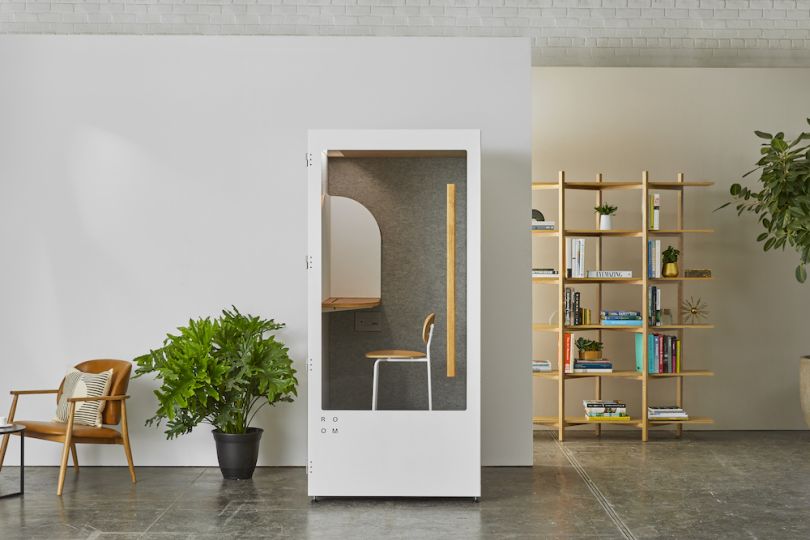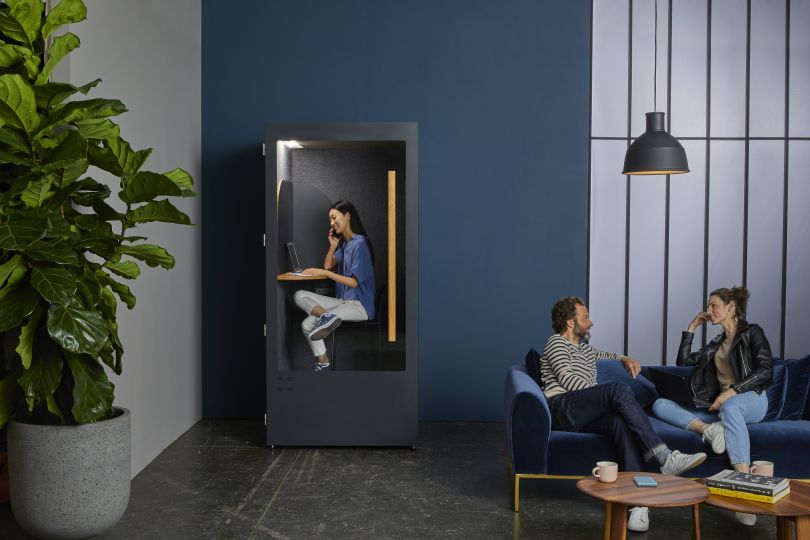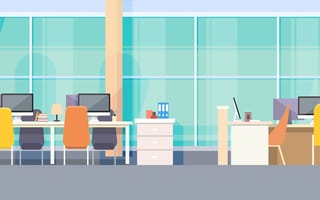Once upon a time, on weekdays, we gathered in cavernous open offices the interior walls of which we could count on one hand. We Slacked each other from mere feet away and breathed in each other’s exhalations.
When we needed privacy, we hid.
“I’ve definitely taken phone calls in stairwells,” Brian Chen, CEO of ROOM, told Built In. “If you’re in the stairwell and talking to your girlfriend ... and you have co-workers walking by, it’s just very uncomfortable.”
Open offices were not supposed to be this way. They were also not supposed to be health hazards, which they are right now, amid the coronavirus pandemic.
They were supposed to save us from cubicle farms; they were supposed to be innovative and modern.
The layout dates back to at least 1939, when Frank Lloyd Wright designed an open office — and, obviously, the concept of open space dates back millennia further. However, the open office as we know it today really took off in the 2000s, especially among tech companies.
Recruitment is so competitive in tech, Chen noted, that companies have to adhere to “the latest trends” in office decor to land top talent. It also helps that the open layout is flexible enough to allow for the rapid, venture-backed growth widely aspired to in the tech industry.
Today, giants like Facebook and Atlassian have open office spaces. The design, proponents say, is conducive to collaboration, creativity and a culture of openness.
But even before offices across the country shuttered, a crop of critics questioned the layout. Was it really conducive to creativity? Were open offices really just a way for companies to save on rent? Did the ease of communication in an open office outweigh the constant distraction and the lack of privacy?
Chen didn’t think so. So at ROOM, launched in 2018, he and his team created a solution: a soundproof booth designed for private calls and focused work in open offices.
The booths balanced out the open office’s panopticon energy, while still allowing for the flexibility and space efficiency that made open plans popular in the first place.
Like the open office itself, ROOM’s booths took off. The company has sold more than 10,000 booths and accrued more than 3,000 unique clients, Chen said — many of them in tech. ROOM booths appear in headquarters for both Twitter and streaming giant Twitch.
The company’s future looked bright. Then 2020 arrived. The coronavirus swept the country, and the primary problem with open offices changed. It was no longer noise; it was that offices were disease vectors. They could literally kill people.
Did ROOM booths have a place in this bleak new landscape? At first some speculated that offices, and by extension ROOM’s booths, would become obsolete.
But it wasn’t actually the end of the office, or the end of ROOM.

Peek Inside the Pod
Though they’re often called “phone booths,” ROOM’s products don’t quite map onto Superman’s phone booth: You have to bring your own phone. The ergonomically designed stations contain only a laptop ledge and an optional stool.
“Some people call them privacy pods,” Chen said. “We like to think of them as purpose-built rooms.”
That’s because, unlike open offices — designed for varied uses, including occasional roller skating — ROOM booths are “optimized for your specific experience”: solitary productivity.
That might mean making a phone or video call.
“In our office, if you have the option of taking a video company call from your desk or from a phone booth, people choose to do it from their phone booth, because it’s just a better experience,” Chen said.
Some ROOM clients also use the booths for telehealth appointments, meditation or just focused work.
“It takes an average of 25 minutes to get into true focus mode,” Chen said. “The moment that you’re distracted, it’s another 25 minutes to focus.”
ROOM’s booths help screen out the noise that disrupts that process. It also seals sound inside the booth, with “sound traps” — plastic-lined channels in the floor and ceiling that let air, but not sound, flow — to ensure privacy.
“When you’re trying to build a soundproof phone booth, there’s a very fine balance to strike between soundproofing and ventilation,” Chen said. “We don’t want a perfectly soundproof phone booth where people are sweating inside and uncomfortable.”
Instead, ROOM booths veer more toward comfort. It’s not just the sound traps — other claustrophobia-killers are built right into the design: plexiglass doors that let in natural light, and internal acoustics that let sound echo slightly. (This ensures entering a booth doesn’t feel like “putting on noise canceling headphones,” Chen said.)
Ventilation, though, was especially key to making the booths comfortable. The booths have interior fans, Chen said, which “replenish the air inside the phone booth basically once every minute,” Chen said.
Now, the booths’ mix of enclosure and ventilation is not just a source of good vibes — it’s a safety feature that may help prevent coronavirus transmission in the weird new world of work.

The Newly Optional Office Is ... Full of Pods?
Recently, tech offices began to cautiously, partially reopen. The buses that ferry tech workers to campuses in Silicon Valley have returned to the San Francisco streets. But the new normal isn’t the old status quo.
For one, many offices have become optional — permanently. Tech giants like Twitter and Facebook have rolled out remote work as a long-term option. (Facebook, however, will prorate pay to reflect new cities’ lower costs of living.)
For another, once-open offices have been revamped to reduce transmission risk. When Salesforce’s offices reopen, for instance, employees will have to have their temperatures taken before they’re allowed into the elevators. The office itself will feature partitions between workstations, and the once-beloved communal candy jars will be gone.
“It’ll be more sterile,” Salesforce’s chief executive, Marc Benioff, told the New York Times. “It’ll be more hospital-like.”
It’ll also be more empty. Chen estimates that only about 15 or 20 percent of the workforce has returned to the office; that’s a small enough population that some offices can assign each employee a personal ROOM phone booth for the day. Some clients are doing just that, Chen said.
Has the booth become the new cubicle?
Temporarily, maybe. Long-term, though, Chen sees offices headed in a more inventive direction — because if they remain optional, aggressively partitioned and hostile to socializing, few will go in.
Chen foresees a rise in space purpose-built for specific activities. Currently, ROOM’s core focus is its booths, but the company is finalizing the design for a modular meeting room.
Long-term, the team plans to make purpose-built, modular spaces for collaboration, one-on-one meetings, meetings that fuse in-person and virtual components, and more.
The pandemic has only “accelerated the need for adaptability in the office,” Chen said.
But open offices needed an upgrade. Their open space served every purpose OK, but they didn’t adapt to and support any one purpose particularly well.
Now that offices are increasingly optional, the only-OK ones will become obsolete. It’s time for tech leadership to dream bigger, Chen said, and ask themselves: “How do we make our office an inspiring place to work?”




